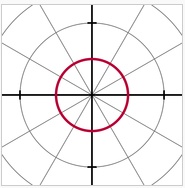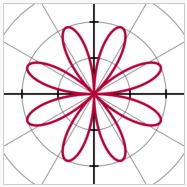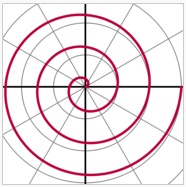Polar Equations & Graphs

The general equation for a circle with a center at (r0, φ) and radius a is
r2 -2rr0cos(θ - φ) +r02 = a2
This can be simplified in various ways, to conform to more specific cases,
such as the equation
r(θ) = a
for a circle with a center at the pole and radius a.
Radial lines (those running through the pole) are represented by the equation
θ = φ
where φ is the angle of elevation of the line; that is, φ = arctan m where m is the slope of the line in the Cartesian coordinate system. The non-radial line that crosses the radial line θ = φ perpendicularly at the point (r0, φ) has the equation
r(θ) = r0 sec(θ - φ)

A polar rose is a famous mathematical curve that looks like a petalled flower, and that can be expressed as a simple polar equation,
r(θ) = a cos(kθ + φ0)
for any constant φ0 (including 0). If k is an integer, these equations will produce a k-petalled rose if k is odd, or a 2k-petalled rose if k is even. If k is rational but not an integer, a rose-like shape may form but with overlapping petals. Note that these equations never define a rose with 2, 6, 10, 14, etc. petals. The variable a represents the length of the petals of the rose.
Archimedean Spiral:

The Archimedean spiral is a famous spiral that was discovered by Archimedes, which also can be expressed as a simple polar equation. It is represented by the equation
r(θ) = a + bθ
Changing the parameter a will turn the spiral, while b controls the distance between the arms, which for a given spiral is always constant. The Archimedean spiral has two arms, one for θ > 0 and one for θ < 0. The two arms are smoothly connected at the pole. Taking the mirror image of one arm across the 90°/270° line will yield the other arm.


